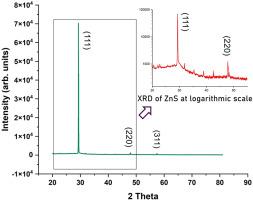Controlled growth of single-crystal ZnS nanoparticles with preferential (111) orientation: Low dislocation density and its impact on luminescence properties
IF 4.2
3区 材料科学
Q2 MATERIALS SCIENCE, MULTIDISCIPLINARY
引用次数: 0
Abstract
Here, single-crystal ZnS semiconductor nanoparticles were synthesized via a wet chemical method, exhibiting a spherical morphology with an average size of 26 nm. XRD profile revealed diffraction peaks along the (111), (220), and (311) planes, with an exceptionally strong intensity along (111). The texture coefficient confirmed a preferential orientation along this plane. Microstructural analysis based on XRD data revealed lower strain and dislocation density compared to previously reported works, strongly suggesting that the lower defect density in (111) preferentially oriented ZnS compared with other polycrystalline ZnS structures. Finally, the influence of the (111) preferential orientation on the emission properties of ZnS was examined through photoluminescence (PL) spectroscopy. The PL spectra show a lower intensity of the blue emission peak at 416 nm, further suggesting that ZnS semiconductor nanoparticles with a (111) preferential orientation have fewer defects and vacancies.

具有优先(111)取向的单晶ZnS纳米颗粒的受控生长:低位错密度及其对发光性能的影响
本文通过湿化学方法合成了单晶ZnS半导体纳米颗粒,其形貌为球形,平均尺寸为26 nm。XRD谱图显示沿(111)、(220)和(311)面的衍射峰,沿(111)面的衍射峰强度特别强。织构系数证实了沿该平面的优先取向。基于XRD数据的显微组织分析显示,与先前报道的作品相比,(111)优先取向ZnS中的应变和位错密度更低,强烈表明(111)优先取向ZnS中的缺陷密度比其他多晶ZnS结构低。最后,通过光致发光(PL)光谱研究了(111)择优取向对ZnS发射性能的影响。发光光谱在416 nm处显示出较低的蓝色发射峰强度,进一步表明(111)择优取向的ZnS半导体纳米颗粒具有较少的缺陷和空位。
本文章由计算机程序翻译,如有差异,请以英文原文为准。
求助全文
约1分钟内获得全文
求助全文
来源期刊

Optical Materials
工程技术-材料科学:综合
CiteScore
6.60
自引率
12.80%
发文量
1265
审稿时长
38 days
期刊介绍:
Optical Materials has an open access mirror journal Optical Materials: X, sharing the same aims and scope, editorial team, submission system and rigorous peer review.
The purpose of Optical Materials is to provide a means of communication and technology transfer between researchers who are interested in materials for potential device applications. The journal publishes original papers and review articles on the design, synthesis, characterisation and applications of optical materials.
OPTICAL MATERIALS focuses on:
• Optical Properties of Material Systems;
• The Materials Aspects of Optical Phenomena;
• The Materials Aspects of Devices and Applications.
Authors can submit separate research elements describing their data to Data in Brief and methods to Methods X.
 求助内容:
求助内容: 应助结果提醒方式:
应助结果提醒方式:


